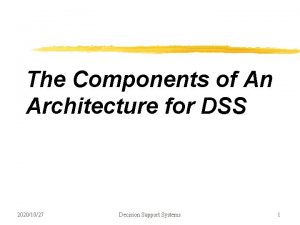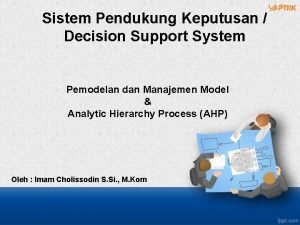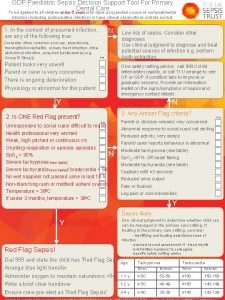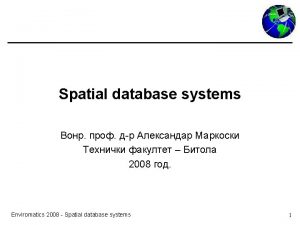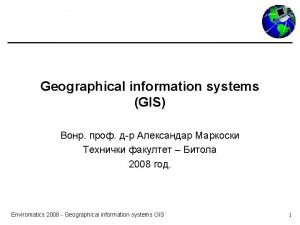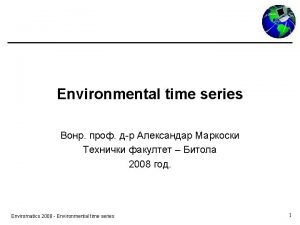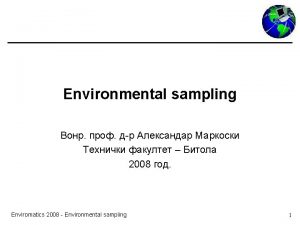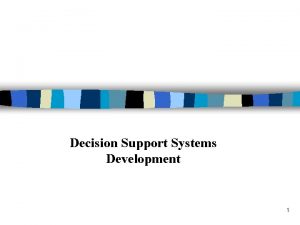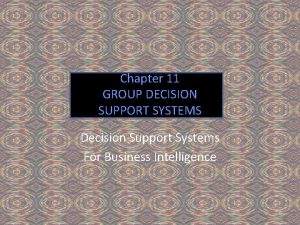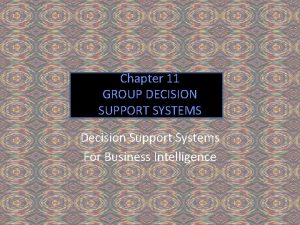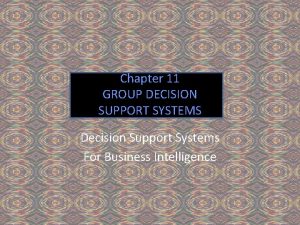Decision support systems 2008 Enviromatics 2008 Decision support


















- Slides: 18

Decision support systems Вонр. проф. д-р Александар Маркоски Технички факултет – Битола 2008 год. Enviromatics 2008 - Decision support systems 1

Introduction • The investigations of environmental systems using mathematical simulation models allow statements for single important state variables while the control and management of environmental systems implies situations of decision making which are characterised by multiple states, concurrent environmental goal functions and also by different evaluation scales and appreciations. Analysing environmental systems two control problems arises: • 1. Theoretical analysis, mathematical description and simulation of the changing environmental system behaviour. • 2. Elaboration of optimal control methods to realise active, goal oriented operations referred to the state and the behaviour of environmental systems. Enviromatics 2008 - Decision support systems 2

• The first statement covers both the biocoenotic-structural and functional analysis of an environmental system and the modelling procedures used to predict changes of environmental states. • The second statement is directed to the use of environmental systems by man and to environmental management and protection. Operating scales and environmental goals are defined by the biotic components of environmental systems and by anthropogenic activities related to environmental management. Enviromatics 2008 - Decision support systems 3

Role of decision making process • Decision making is one of the main concepts to manage environmental systems. • The decision making process itself is characterised by choice of one objective allowable kind of action related to a subjective valuated compromise on partly satisfaction of the concurrent and conflicting environmental goals. • Optimisation models of environmental management mainly deal with some form of cost minimisation designed to meet environmental quality and/or ecological standards. Decisions are based on scenarios resulting from simulation models. • The individual weighting of the goal functions often depends from their actually reachable system states. In search of all possible alternatives for controlling a dynamic system by restricting standards and socio-economic goals the use of a computer will be very helpful. 4 Enviromatics 2008 - Decision support systems

• The application of optimality principles to environmental systems is burdened with difficulties of fundamental nature. In the most cases, environmental system analysis is essentially a conflict analysis characterised by socio-economical and environmental value judgements. • The regulations of environmental system evaluation are open to the methods of environmental law. This implies that a multirelated environmental process or system will always be understood as a search for acceptable compromise solutions which requires an adequate evaluation methodology. • Multiple-criteria decision making techniques aim at providing such a set of tools. Pareto-optimisation technique seems to be an adequate method to evaluate multi-goal functions of ecosystems. Enviromatics 2008 - Decision support systems 5

• Multiple contradictory goals require decisions which are influenced by the dynamic characteristics of system compartments and their interrelationships, by the kind of anthropogenic actions onto the aquatic ecosystem to be managed. • For this reason, water quality simulation models proved to be an indispensable assessment tool. • The management procedure involves sampling of data, selection of appropriate and validated simulation models and, finally, decision analysis as well as visualisation of results by GIS. Enviromatics 2008 - Decision support systems 6

Environmental management strategies • Environmental management is a very difficult and complex task. It requires mathematical models not only for different time horizons but also for different management strategies. Simulation models allow a process control related to special goals of ecosystem management. • Most often the goal is a suitable control scheme which presents a compromise between the available budget for prevention measures and an acceptable environmental quality. Therefore, environmental management strategies deal mainly with some form of operational cost minimisation to meet environmental quality and ecological standards. Then, management decisions can be made by ranking of different scenarios resulting from simulation models. Enviromatics 2008 - Decision support systems 7

Computer-aided decision making process • The computer-aided decision making process can be divided into three steps. Two of them are subjective parts and one is an objective part of the decision making process: • 1. Formulation of the decision problem In this subjective part the decision variables and the contradictory goal functional are defined. • 2. Computation of proposals for decision making. In this objective part of decision making a set of efficient alternatives will be generated by multi-objective optimisation. The dominant alternatives are selected and stored in the result domain. • 3. Actual decision making process. This subjective part of the decision making process covers the computer aided selection of a compromise by individual weighting of the goal functions by the decision maker. Enviromatics 2008 - Decision support systems 8

Three main requirements • Solving a decision problem three requirements have to be fulfilled: 1. Each solution of the decision problem is an efficient alternative (problem of validity). 2. Each efficient alternative may be a solution of the optimisation procedure (problem of non-discrimination). 3. A solution of the decision problem is an efficient alternative, if it is existent (problem of identification). Enviromatics 2008 - Decision support systems 9

MADM and MODM • Another distinction of decision making problems can be made by multiple attribute decision making (MADM) or multiple objective decision making (MODM). • In the first case the alternatives can be explicitly evaluated by discrete values of the goal functions. • In the latter case the evaluation of alternatives is implicitly given by a functional and can change continuously in the domain of admissible solutions. • In such cases an important feedback between optimisation and modelling procedures arises. Enviromatics 2008 - Decision support systems 10

4 phases in multi-criteria decision process • A multi-criteria decision making process is given by four different phases. During the first phase (search phase) a system will be analysed for changes in the structure and the function. If the results of analysis are positive then one or more decision making problems arise as a result from this first phase. • The second phase (modelling phase) is characterised by formulations of the goal functions, by the directions of alternatives, by the modelling process and by the imbedding procedure of the simulation model into the optimisation procedure. Enviromatics 2008 - Decision support systems 11

• The third phase (selection phase) is represented by choosing one alternative of action of the set of all alternatives. This special alternative has to be implemented into the system under consideration. • The fourth phase is characterised by the decision making process. The decision making problem is represented by a set of alternatives which contribute to reach the different goals. For a given decision problem the set of allowable alternatives is defined by external (real) conditions. Enviromatics 2008 - Decision support systems 12

• Decision support for environmental management means that a final state can be reached by different ways of action starting from an initial state. The final state is described by any number of conflicting criteria. A decision of an individual means then a selection of one (subjective preferred) vectorial evaluated alternative of action of a set of all objective allowable alternatives to reach the final state. Enviromatics 2008 - Decision support systems 13

Decision support systems classification • The decision making process is mostly based on interactive decision support systems (DSS) with hierarchical structures. The hierarchy is given by different working levels: Preparation level, simulation level, testing level and optimisation level. • DSS can be classified by simple software tools (e. g. data bases), by expert systems and knowledge based systems (recognition of special environmental situations) and by model based DSS. • From the last classification type the decision maker gets support by using of vector optimisation procedures or by multicriterial selection procedures to generate and/or to select alternative ways of action. Enviromatics 2008 - Decision support systems 14

Four main components of DSS • DSS consist of four main components: 1. Component of communication (communication between the DSS and an user(e. g. decision maker)). 2. Component of model and/or knowledge base (formulation of the actual decision problem). 3. Component of problem solving (solving procedures of vector optimisation problems). 4. Component of visualisation (use of GIS). Enviromatics 2008 - Decision support systems 15

The search process Enviromatics 2008 - Decision support systems 16

Enviromatics 2008 - Decision support systems 17

Environmental Decision Support System Enviromatics 2008 - Decision support systems 18
 Decision support systems and intelligent systems
Decision support systems and intelligent systems No decision snap decision responsible decision
No decision snap decision responsible decision Financial decision
Financial decision Decision support and business intelligence systems
Decision support and business intelligence systems Developing spreadsheet-based decision support systems
Developing spreadsheet-based decision support systems Decision support system in business intelligence
Decision support system in business intelligence Decision support and expert systems
Decision support and expert systems 2008 2008
2008 2008 Council framework decision 2008/913/jha
Council framework decision 2008/913/jha Decision tree and decision table
Decision tree and decision table Types of tps
Types of tps Dss architecture components
Dss architecture components Contoh decision support system adalah
Contoh decision support system adalah Navify decision support
Navify decision support Gdp sepsis decision support tool
Gdp sepsis decision support tool Components of decision support system
Components of decision support system Gdss
Gdss Group decision support and groupware technologies
Group decision support and groupware technologies Characteristics of a decision support system
Characteristics of a decision support system











